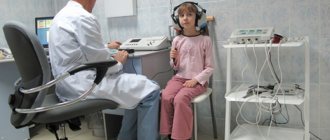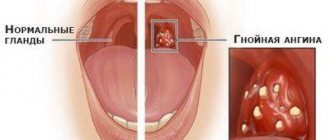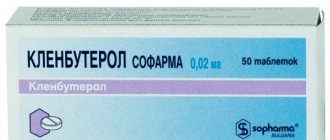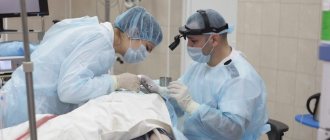The palatine tonsils, like other lymphoid formations of the pharyngeal ring, belong to immune structures. They take on the attack of the infection when it tries to enter the body. To combat pathogenic microorganisms, lymphoid tissue can normally increase slightly, but after victory it returns to its previous size.
Thus, temporary hypertrophy of the palatine tonsils of the 1st degree is a variant of the norm for the acute period of an infectious disease. Enlargement of the tonsils to grades 2 and 3 leads to the appearance of symptoms of the disease and requires treatment. The pathology often occurs among children.
Hypertrophy of the tonsils can develop in parallel with an enlargement of the pharyngeal or lingual tonsil. Often, enlarged tonsils are diagnosed against the background of adenoids and vice versa.
Tonsils, depending on their size, can be classified as follows:
- 1st degree - characterized by a decrease in the throat lumen by a third;
- in the second degree – the diameter narrows by 2/3;
- the third degree is characterized by the connection of the surfaces of the tonsils, which completely closes the lumen of the throat.
Causes of hypertrophy
It is not possible to say exactly why the tonsil becomes hypertrophied. However, we can say with confidence that this is a protective reaction of the body to the action of an unfavorable factor.
In children, due to the underdevelopment of the immune system, lymphoid tissue is very variable, so its hyperplasia does not require long-term exposure to a damaging factor.
Predisposing factors that cause the proliferation of lymphoid tissue, which causes hypertrophy of the palatine tonsils in children, include:
- decreased immune defense;
- exacerbation of chronic pathology;
- poor nutrition;
- frequent infections (ARVI, influenza);
- the presence of infection in the throat (pharyngitis) or nasopharynx (sinusitis);
- chronic tonsillitis, when microbes accumulate in the folds of the mucous membrane, supporting the inflammatory reaction;
- heavy physical activity;
- dry polluted air;
- occupational hazards.
Note that children whose parents suffered from adenoids or had their tonsils removed, that is, with a burdened heredity, suffer more often.
Causes
The tonsils or palatine tonsils are paired formations that are located between the tongue and the soft palate.
At the same time, the size of the tonsils in children is different - in some they are practically invisible, while in others, during pharyngoscopy you can see how they protrude beyond the edges of the palatine arches. The tonsils play an important role in the formation of immunity; they are a lymphoid organ. It should be noted that when a child is born, he has very immature tissue of the tonsils; as he grows, it improves. As children grow, they often come into contact with various infections and viruses; in cities they breathe polluted air and tobacco smoke. Because of this, the developing tissues try too hard to protect the body and grow, which causes enlargement of the tonsils. This does not happen to all children; the most important role is played by heredity, asphyxia during childbirth, and viral and infectious diseases during pregnancy. However, the above reasons only to some extent contribute to the development of the disease; the exact reasons are not known to science.
If enlargement of the tonsils in children is not a fully studied phenomenon, then in adults such a symptom in almost all cases indicates chronic tonsillitis. But the main difference between tonsillitis is that with hypertrophy of the tonsils there is no inflammatory process.
How does it manifest?
When contacting an otolaryngologist, in most cases, proliferation of lymphoid tissue not only of the tonsils, but also of the pharyngeal tonsil is diagnosed. The severity of clinical symptoms depends on the degree of hypertrophy of the tonsils and blockage of the lumen of the larynx.
When you try to independently examine the tonsils in the mirror, only in the second and third degrees can you notice their enlargement. Stage 1 growths are not so noticeable, so a person does not pay attention to the symptoms. Gradually, when grade 2 hypertrophy of the tonsils develops, signs indicating the disease begin to appear. As the tonsils enlarge, they become fused with each other and the uvula.
The consistency of the tonsils becomes compacted with a hyperemic (with inflammation) or pale yellow color. Clinically, a hypertrophied appearance of the tonsils can be noticed by the following signs:
- the child begins to breathe heavily, this is especially noticeable when he plays outdoor games;
- difficulty swallowing;
- a foreign element is felt in the pharynx;
- The voice changes and becomes nasal. Sometimes it is not possible to understand what the child is saying the first time, because some sounds are distorted;
- Sometimes snoring and coughing are noted.
With further growth of lymphoid tissue, the passage of solid food becomes difficult. When the tonsils become inflamed, a sore throat develops. It is characterized by:
- acute onset;
- rapid deterioration of condition;
- febrile hyperthermia;
- purulent plaque on the tonsils, suppuration of the follicles, pus in the lacunae.
Diagnostic examination
To make an accurate diagnosis, you need to see a doctor:
- at the first stage, the doctor interviews complaints, studies the features of their occurrence, and also analyzes the life history (living conditions, previous and existing diseases). In addition, regional lymph nodes are palpated for inflammation;
- at the second stage, pharyngoscopy is performed, which makes it possible to examine the condition of the tonsils, assess the extent of the process and determine the degree of proliferation of lymphoid tissue. Rhinoscopy is also recommended;
- the third stage includes laboratory diagnostics. For this purpose, the patient is sent for microscopy and cultural examination. The material for examination is a smear from the tonsils.
Tests make it possible to confirm or exclude infectious lesions of the tonsils, as well as to establish the sensitivity of microbes to antibiotics.
To identify complications, otoscopy, rigid endoscopy, fibroendoscopy and ultrasound are performed. During the diagnostic process, hypertrophy must be differentiated from chronic tonsillitis, oncopathology and abscess.
Diagnostics
First of all, the doctor examines the patient's medical history. He is interested in frequent tonsillitis and viral infections. From laboratory tests the following are prescribed:
- urine and blood tests;
- biochemistry;
- bacteriological examination of a smear from the tonsils.
Instrumental types of procedures include the following:
- Ultrasound of the pharynx;
- pharyngoscopy;
- endoscopy.
This pathology should be differentiated from tumor formations, infections of the oropharynx, and leukemia.
Conservative direction in treatment
Before deciding what to use for treatment, it is necessary to analyze the diagnostic results. It is especially necessary to take into account the degree of proliferation of lymphoid tissue, the presence of infection and the inflammatory process.
For systemic action the following may be prescribed:
- antibacterial agents (Augmentin, Zinnat);
- antiviral drugs (Nazoferon, Aflubin);
- antihistamines that reduce tissue swelling (Diazolin, Tavegil, Erius);
- vitamin therapy.
For local effects, rinsing the throat with solutions with antiseptic and anti-inflammatory effects is indicated. Furacilin, Chlorhexidine, Givalex and Miramistin are suitable for the procedure. Rinsing with herbal decoctions (chamomile, yarrow, sage) is also allowed.
If necessary, lubrication of the tonsils with solutions with an antiseptic, drying and moisturizing effect is prescribed. To adequately assess the effectiveness of drug therapy, it is necessary to regularly visit a doctor and undergo diagnostics. You can achieve good results by simultaneously strengthening your immune defense.
Surgical intervention
Hypertrophy of the palatine tonsils grade 3 in children should be treated surgically. With such an increase in the tonsils, not only the symptoms of the disease are disturbing, but complications also appear. Impaired breathing is fraught with hypoxia, which makes the child drowsy, inattentive and capricious.
Removal of tonsils, or tonsillectomy, lasts no more than 50 minutes.
To prepare for surgery, it is necessary to undergo a full examination to identify contraindications.
Surgery may be tolerated if:
- acute course of an infectious disease;
- exacerbation of chronic pathology;
- coagulopathies;
- uncontrolled diseases of the nervous system (epilepsy);
- severe bronchial asthma.
In consultation with an otolaryngologist, the issue of removing the adenoids along with the tonsils may be considered if they are hypertrophied. Before surgery, it is necessary to find out the presence of allergic reactions to local anesthetics (novocaine, lidocaine).
Surgery can be performed under local anesthesia or general anesthesia. This is determined by the anesthesiologist during the conversation and based on the diagnostic results.
Typically, tonsillectomy is performed as planned, so the child can be fully examined, thereby preventing complications and easing the postoperative period.
Hospitalization for surgery is carried out when the child:
- labored breathing;
- snore;
- speech is changed;
- hypertrophy of the palatine tonsils, grade 3.
In the postoperative period, as before surgery, parents should be with the child. This will calm him down a little and make the surgeons’ work easier. If the child is emotionally labile, in order to prevent him from being pulled out of the hands of the medical staff during the operation, general anesthesia is chosen.
Immediately after the operation, it is forbidden to cough or talk, so as not to injure the blood vessels and cause bleeding.
Do not be alarmed if your child produces copious amounts of saliva mixed with blood. In consultation with your doctor, you can drink water after a few hours, preferably through a straw.
Starting from the second day, liquid foods are allowed, such as yogurt, kefir or broth. Brushing your teeth should be postponed for several days. We emphasize that after the operation you may:
- Pain when swallowing appears as a response to tissue injury. Analgesics are prescribed to reduce pain;
- low-grade hyperthermia;
- regional lymphadenitis;
- crusts in the throat;
- blood in saliva.
Discharge is possible after 10 days. However, this does not mean that you can return to your normal life. The consumption of solid foods, hot drinks and heavy physical activity is also prohibited. It is necessary to remember about the gentle voice mode.
With a slight enlargement of the tonsils, dynamic observation of children by a doctor is necessary, because the size of their tonsils can be normalized. Complications of the operation are extremely rare, so it is considered simple for otolaryngology.
Preventive measures
To protect your child from surgery, it is enough to adhere to the following recommendations:
- regularly visit the dentist for a routine examination, because caries is a chronic infection;
- promptly treat inflammation and infections of the throat (tonsillitis) and nasopharynx (sinusitis);
- prevent chronic diseases of internal organs;
- Healthy food;
- devote enough time to sleep and rest;
- often walk in the fresh air;
- regularly ventilate the room, do wet cleaning and humidify the air;
- play sports (swimming, cycling);
- avoid contact with allergens;
- minimal contact with people sick with infectious diseases;
- do not visit places with large crowds of people during a flu epidemic;
- to harden;
- heal the body in sanatoriums on the seashore, in a forest area or in the mountains.
Tonsil hypertrophy in children is a fairly common pathology, but this does not mean that it cannot be avoided. Attention to a child’s health should be paid from birth to create a strong foundation for life.
Overgrowth of the glandular tissue of the palatine tonsils occurs in childhood. In the period from 2 years to puberty, children are diagnosed with enlarged tonsils. The causes of the pathological process lie in the underdeveloped organs of the lymphoid system located in the throat.
How does pathology manifest itself in children?
The tissue of the tonsils grows, they occupy more volume in the throat, but there is no inflammatory process. The color and consistency of the organ does not change. Hypertrophy of the tonsils in children occurs regularly; girls and boys are equally susceptible to this process. Treatment depends on the degree of tissue proliferation.
At the first examination, the doctor will determine which tonsils are affected:
- Palatine and tubal (paired) glands. The first are located on the sides of the entrance to the pharynx, the second in the hearing organs.
- Pharyngeal and lingual (unpaired) glands. The first is located on the back wall of the pharynx, the second under the tongue.
The organs of the lymphatic system protect the body from infection, dust and viruses. In a child, they cannot fully perform their functions, since they are not yet developed enough.
Formation finally ends by the age of 12, and then it is expected that the hypertrophy of the palatine tonsils will begin to decline. Not all children require mandatory treatment.
Symptoms
With hypertrophy of the palatine tonsils, there is a disturbance in the respiratory rhythm, snoring during sleep, and in some cases apnea occurs. The voice also changes and a nasal sound appears.
Their surface becomes loose, uneven, and their volume increases. Often, hypertrophy of the palatine tonsils is accompanied by a similar process in the pharyngeal tonsils.
Unilateral hypertrophy of the palatine tonsils in children requires special attention, as it may indicate the presence of a fungal infection, syphilis, tuberculosis, or tumor. With hypertrophy of the pharyngeal tonsil, otitis may develop, and ventilation of the nasal sinuses is impaired. A child with this pathology is often bothered by inflammation of the trachea, pharynx, and bronchi. Hypertrophy of the lingual tonsil is accompanied by a constant cough, bubbling breathing, sensation of a foreign body in the throat, and difficulty swallowing.
Causes of tonsil enlargement
The palatine and pharyngeal glands are involved in the process. Overgrowth is provoked by recurring sore throats. The chronic inflammatory process largely affects the pharyngeal tonsil, then parents hear the diagnosis “adenoiditis”.
Treatment at the initial stage is aimed at relieving inflammation and reducing the volume of the gland. In serious cases, when hypertrophy of the glands affects breathing, impairs sleep and interferes with normal feeding, surgical removal (complete or partial) is indicated.
During the inflammatory process, the volume of the tonsils increases, and the number of lymphocytes in them increases, which protect the body from invading pathogens. With repeated infections and weak immunity, the tonsils do not have time to recover from inflammation and return to normal size. Staying in an increased state becomes chronic, which becomes a pathology.
There are many more factors for hypertrophy of the lymphatic organs; pharyngoscopy helps to establish the true cause:
- susceptibility to allergies;
- unsuitable climate;
- caries, stomatitis, thrush;
- structural features of the maxillofacial apparatus;
- adrenal disease.
Symptoms of gland hypertrophy in a child
Parents tend to attribute changes in the child’s body to the inflammatory process of a cold. However, when the infection is cured, but breathing is difficult and the child is nasal, this is a reason to consult a doctor.
The following conditions cause a visit to the doctor:
- At night, the baby’s breathing is uneven, sometimes with effort;
- breathing through the mouth predominates;
- the child is inhibited, speaks and hears poorly;
- speaks “on the nose”;
- difficulties with the pronunciation of consonants;
- pale skin;
- feeling of nasal congestion.
The child is lethargic, gets tired quickly, and may complain of a headache.
Hypertrophy of the nasopharyngeal tonsil
Often, the pathology of the palatine tonsils is accompanied by pharyngeal hypertrophy. It is a small formation of lymphoid tissue located in the vault of the pharynx. In addition to hypertrophy, the nasopharyngeal tonsil may be in a state of acute or chronic inflammation. In the literature you can find other names for this pathology: adenoid vegetations, growths of adenoids.
Visually, hypertrophy of the pharyngeal tonsil is a spherical formation on a wide base.
As is the case with changes in the palatine tonsils, pharyngeal hypertrophy is classified according to severity:
- During wakefulness, nasal breathing is not impaired. When the child takes a horizontal position, the hypertrophied nasopharyngeal tonsil increases in volume. The consequence of this is difficulty breathing. Apnea occurs.
- The altered tonsil practically blocks the entrance to the nasopharynx.
- Adenoid vegetations completely block the entrance.
At stage I of the disease, there may be no complaints.
Sleep apnea may be a reason to seek medical help. At stages II and III, symptoms of hypertrophy of the pharyngeal tonsil become pronounced. The child almost always breathes through his mouth, complains of a headache, and sleeps restlessly. There is hearing and speech impairment, memory and performance decrease. Viral and bacterial diseases of the respiratory tract become constant companions of the patient.
With a long course of the disease, a specific structure of the facial skull is characteristic: the child’s face has an elongated shape, the mouth is slightly open, the upper teeth protrude forward. The structure of the chest also changes. The sternum, ribs and costal cartilages protrude forward in the form of a wedge. This condition is popularly called “chicken breast”.
Forms of manifestation of hypertrophy
To select treatment, the degree of enlargement of the gland is determined. To do this, the doctor examines the oral cavity and palatine tonsils, which are visible without the use of special instruments.
In children, it is customary to distinguish 3 degrees of tonsil hypertrophy:
- Visually, the palatine tonsils are enlarged, occupying a third of the height from the tongue to the arch of the palate.
- The lymph glands exceed the midline of the pharynx in height.
- The tonsils close the lumen of the pharynx, tightly touch or overlap each other.
Tonsil hypertrophy of degrees 1 and 2 in children requires hygiene, cleaning the mouth, rinsing with water and antiseptic solutions. When stage 3 overgrowth of the palatine tonsils has been established, partial or complete removal of the gland tissue is considered.
What are the dangers of a one-sided process?
When an infection occurs, both glands become “activated.” When the process becomes chronic, their simultaneous growth occurs. But, in rare cases, unilateral hypertrophy of the tonsils is diagnosed, which is considered a dangerous symptom.
In this case, you need to urgently visit a doctor to determine the cause of the pathology. The child is shown to an oncologist, a phthisiatrician and a venereologist. The cause of the growth of the gland is lung disease (tuberculosis), syphilis, and a tumor process. Tests help to establish a diagnosis: blood, smears, instrumental examination.
Unilateral proliferation of the tonsil occurs due to the anatomical features of the structure of the pharyngeal organs. In this case, no therapy is required.
Treatment of tonsils with overgrowth
In the initial stages, conservative methods are used:
- rinsing;
- physiotherapy;
- inhalation;
- mouth sanitation
Restores the tonsils or prevents their further growth.
Recommended for children:
- trips to the sea;
- hardening and air baths;
- strengthening the immune system;
- varied diet.
If a pathological enlargement of the gland complicates the life of a small patient, an operation is performed to remove or partially excise the lymphatic tissue.
In case of pathology of the tonsils, observation of the small patient and compliance with the doctor’s instructions are indicated. With a high probability, the lymph glands will return to normal size and will perform their functional tasks.
When treating any disease, the main focus of activities to achieve a positive result is to eliminate the causes of the disease and stimulate the functioning of the immune system.
If the disease in question is detected in mild or moderate severity, treatment of tonsil hypertrophy in children is carried out mainly with medication. To treat the area of deformation, astringent and cauterizing medical compounds are used.
Tannin. This medicinal solution (in proportions of 1:1000) is used to rinse and lubricate the pharynx and tonsils. This drug has no contraindications, except for hypersensitivity to the components of the medication.
Antiforminum (antiseptic). This drug is used as a rinse to disinfect the oral cavity and the area of the tonsils and pharynx. Rinsing is carried out with a 2 - 5% solution of the drug.
Silver nitrate (Argentnitras). To eliminate inflammatory processes and using the astringent property, a 0.25-2% solution of the drug is lubricated on the mucous membrane of the tonsils; if cauterization is necessary, the percentage of silver nitrate in the solution is increased to two to ten percent. In this case, a single dosage for adults should not exceed more than 0.03 g and a daily dosage of more than 0.1 g. No contraindications for this medication have been identified.
Lymphotropic drugs, drugs with antimicrobial and antiviral effects are also attributed. For example, such as:
Umkalor. This drug should be taken half an hour before meals with a small amount of water.
The dosage for children from one to six years is 10 drops. Reception is carried out three times a day.
For children aged six to twelve years, the one-time dosage should not exceed 20 drops. Take three times a day.
For children over the age of 12 years, umcalor is prescribed in a dosage of 20–30 drops.
Most often, the course duration is ten days. The drug is continued for several days after the symptoms of the disease have disappeared. If relapses of the disease occur periodically, the treatment course is continued, but with a lower dosage.
Lymphomyosot. This medicine is prescribed to a child in a dosage of 10 drops taken three times a day. The course of treatment is prescribed by the doctor observing the baby based on the clinical picture of the disease and the severity of its manifestations. No side effects or contraindications were identified, except for hypersensitivity to the components of the drug.
Tonsilgon. This is a combination medicine based on herbal ingredients. Form of administration of the drug: tablets and aqueous-alcoholic extract of a cloudy yellow-brown color. It is used for inhalation. This drug has no special contraindications, with the exception of individual intolerance to the constituent components of the drug.
Tonsilotren. The drug tablets dissolve in the mouth. If the course of the disease is indicated by acute manifestations, the attending physician prescribes the following dosage protocol: for two to three days, after every two hours, the small patient should dissolve two tablets. The duration of the course is up to five days.
If the disease does not manifest itself so acutely, then for children aged ten to 14 years the drug is prescribed two tablets, taken twice a day. This medicine is not recommended for children under ten years of age. If the symptoms of the disease disappear within three days, the drug is discontinued, otherwise treatment can be extended to five days. In case of relapse, the duration of treatment can be increased to two to three weeks, divided into several courses.
It is not recommended to administer this drug to children under ten years of age, pregnant women and women during breastfeeding, as well as patients with liver and kidney failure. It should be taken with caution by elderly people and patients with severe diseases of the gastrointestinal tract or thyroid gland.
For this disease, non-drug methods are often used for medicinal purposes:
- Application of ozone therapy. The baby breathes ozone for a prescribed period of time.
- Spa treatment. Such patients are referred to climatic and balneo-mud sanatoriums.
- Ultrasound therapy provides treatment by applying ultrasound to the tonsils.
- Vacuum hydrotherapy. Rinsing and treating tonsils with mineral and sea water.
- Carrying out inhalations with decoctions and oils of plants that have an antiseptic effect (sage, chamomile...), mineral water and mud solutions.
- Peloid therapy. Applying mud compresses to the submandibular area.
- Electrophoresis with healing mud.
- Oxygen cocktails.
- UHF and microwave. Irradiation of the submandibular region with lymph nodes.
If it is not possible to restore the original size of the tonsils using medicinal and non-medicinal methods and the process threatens to enter the stage of a chronic disease, the otolaryngologist is forced to opt for a tonsillotomy. This is a surgical intervention in which part of the changed lymphoid tissue is removed. This operation is performed under general anesthesia. The baby is put to sleep, holding the tongue with a spatula, and the part of the tonsil that protrudes beyond the accepted size is resected.
If necessary, a tonsillectomy is performed - complete resection of the tonsils. Not so long ago, such surgical intervention was the norm. Today, this operation is prescribed quite rarely (for chronic peritonsillar abscesses), since with complete removal of the tonsils, Waldeyer's ring is ruptured and the defense line along the path of infection is destroyed.
Traditional medicine is also ready to offer several recipes that help with tonsil hypertrophy in children.
- It is necessary to teach your baby to rinse his mouth after every meal. Such a simple procedure will not only cleanse the mouth of food debris (bacteria), but also introduce an element of hardening. Moreover, problems with the child should not arise, since children play with water with pleasure. You can rinse with regular water, or you can use herbal decoctions (sage, calendula, oak bark, mint, chamomile).
- You can use ointments: mix aloe juice and honey in a ratio of 1:3. Lubricate the tonsils with this ointment. You can also simply apply aloe juice alone.
- Rinsing with a solution of sea salt (sea water) is also effective. For a glass of soda at room temperature, or a little higher, put one to one and a half teaspoons of salt.
- It is very good to rinse with a decoction of iodine-rich walnut leaves.
- It is effective to lubricate the tonsils with propolis oil, which is done quite simply at home. Add one part propolis to three parts vegetable oil. Heat for 45 minutes in the oven or in a water bath, stirring. Leave to brew for a while and strain. This composition can be stored for a long time in a cool place.
- You can also lubricate your tonsils with apricot, almond and sea buckthorn oil.
The very first barrier that is encountered on the path of any infection that wants to enter the human body through the respiratory system and oral cavity is the palatine tonsils. They consist of lymphatic tissue, have an oval shape and in a healthy state are very compact in size. However, sometimes they increase in size due to the development of an inflammatory process in their tissues.
Treatment
When a doctor diagnoses “Hypertrophy of 1-2 degrees”, drug treatment is most often prescribed:
- Gargling with solutions of Furacilin, Miramistin, Antiformin.
- Treatment of the tonsil area with a silver solution.
- Use of homeopathy: Tonsilgon, Tonsilotren, Sinupret, Lymphomyosot, Umkalor.
- The use of drugs to strengthen the immune system: IRS-19, Immudon, Lizobkat.
- In case of exacerbation, the use of antibacterial drugs is prescribed, including treatment of the tonsils with antiseptic solutions.
Physiotherapeutic
Also, in addition to drug treatment, patients are prescribed physiotherapy:
- ozone therapy;
- tube-quartz;
- vacuum hydrotherapy;
- balneotherapy;
- inhalation;
- mud applications;
- phonophoresis;
- laser treatment.
Surgical
For grade 2-3 hypertrophy of the tonsils, which is accompanied by frequent exacerbations, as well as breathing, speech and hearing problems, the doctor prescribes surgical removal of the tonsils.
The operation is performed using general anesthesia. After 2 days, with normal health and no complications, the patient is discharged from the hospital.
Folk remedies
Some folk recipes for the treatment of hypertrophy of the palatine tonsils:
- For a decoction of herbs, you need to take flowers of chamomile and calendula, coltsfoot, thyme, St. John's wort, wormwood, eucalyptus leaves and black currant. Brew a teaspoon of thoroughly mixed mixture with 250 ml of water, boil for 2-3 minutes, strain. Let it brew for at least 3 hours. Take the decoction twice, 50 ml daily. You can also gargle with the resulting decoction.
The following recipe is also effective: mix sage herb, calendula flowers, chamomile, with wild rosemary herb and linden blossom. Pour the mixture with 250 ml of water and boil for 3 minutes. Let it brew for about 5-6 hours. Take this infusion three times a day, 20-30 ml, and also gargle.- Propolis is crushed and mixed with alcohol in equal parts. Infuse the composition for 5 days in the refrigerator. The resulting tincture should be taken three times a day, 20 drops or diluted in warm water. Use it for 2 weeks, then take a week off, again 2 weeks of treatment, a week break, take it again for 2 weeks.
- For hypertrophy of the palatine tonsils in children, propolis is mixed with butter in a water bath in equal proportions. Add honey to the mixture. This medicinal product is stored in a jar in a cold place.
- You can also make garlic drops from five cloves of garlic mixed with a couple of teaspoons of vegetable oil. Leave for five days in an airtight container. Next, it is recommended to strain and add two drops of lemon juice. Take 10 drops morning and evening. It is advisable to mix well before use.
- An infusion of clove flowers also helps. Pour 5 clove flowers with a quarter cup of boiling water and let it brew for at least two hours. Take 20 g three times a day for 20 days. It is recommended to conduct the course at least twice a year.
- 3 tablespoons of St. John's wort are poured into a glass of vegetable oil. Let it brew for at least 20-25 days in the dark. Strain. Treat enlarged tonsils three times a day.
- You can chew at least ten sea buckthorn berries throughout the day. Continue treatment for 40 days.
- The tonsil area can be treated with alum powder. You can make a solution for rinsing the larynx.
- Lubricating the tonsil area with juice prepared from aloe leaves 3 times a day also helps. You can also mix aloe juice with honey.
- You can also gargle with a homemade solution of sea salt. Take a spoonful of salt and dilute it in warm water. Instead of sea solution, they also rinse with mineral water.
It is necessary to rinse and treat the tonsils after first clearing the throat of food and various drinks from the throat with water. After treatment, do not eat or drink immediately. The break between treatment and eating should be at least 30-60 minutes.
Development of hypertrophy of the palatine tonsils in children
The palatine tonsils are located between the tongue and the soft palate; in addition to them, there are also nasopharyngeal, lingual and two tubal tonsils. All of them create a lymphopharyngeal ring, the main function of which is to protect the nasopharynx, respiratory tract, bronchi and lungs, as well as the gastrointestinal tract from attacks of various infections.
Sometimes the palatine tonsils (tonsils) begin to increase in size in the complete absence of an inflammatory process in them. This is hypertrophy of the palatine tonsils or hypertrophic tonsillitis, which is very common in children.
This condition in children most often occurs under the influence of harmful environmental factors. Immediately after birth, the lymphatic tissue of the tonsils is immature, but during the process of growing up, the cells of this organ undergo differentiation and it matures. When exogenous factors influence the palatine tonsils during this period, an inadequate response of the tissues of this organ occurs and their enlargement occurs.
As mentioned above, the development of hypertrophy of the palatine tonsils in children is the immune system’s response to various unfavorable factors and environmental conditions. As a rule, already at the age of 3-5 years, children enter the team and begin to actively communicate with each other. In addition to the joy of communication, these meetings bring an increase in the load on the not yet matured immune system.
Many viruses, inorganic substances and bacteria that the child inhales along with the air contribute to an increase in the tissue of the tonsils.
Hypertrophy of the palatine tonsils, a photo of which can be seen below, is a kind of adaptation of the body:
Also, enlargement of the tonsils can be caused by poor nutrition, frequent acute respiratory viral infections and hypothermia. However, the reasons for the development of such hypertrophy in each case are very individual; the constitutional characteristics of the child and heredity play a large role here.
Tonsil hypertrophy: clinic
This term refers to an immunoreactive state, which is one of the symptoms of the compensatory abilities of the pharyngeal ring. This occurs when the body adapts to different conditions. Provoking factors can be hypothermia of the tonsils, diseases of the nasopharynx and other anomalies.
Most often, unilateral or bilateral hypertrophic changes affect the palatine tonsils, which are localized in the oropharynx. In children, lesions of the nasopharyngeal tonsil - adenoids - are often detected. In more rare cases, the lingual tonsil is affected. According to ICD-10, this pathology is coded under the code J31.1. Hypertrophy of the tonsils.
Symptoms of hypertrophy of the palatine tonsils
As a rule, minor changes in the size of this organ do not bother children in any way. But as the process progresses, an increase in the size of the tonsils can cause the development of the following negative symptoms:
- change in voice - the child speaks through his nose, as if he has developed rhinitis with nasal congestion. Speech is also deformed, it becomes poorly intelligible, “blurred”;
- nasal breathing is disrupted - the child is forced to breathe either through the mouth or through the nose. In this case, sleep disturbance is observed (it becomes restless and short-lived), mood deterioration and increased irritability;
- Snoring occurs during night sleep - this can lead to holding your breath.
Such symptoms of tonsil hypertrophy are an absolute and urgent reason to visit a doctor.
Degree of development of hypertrophy of the palatine tonsils
It is customary to distinguish three degrees of hypertrophy of the palatine tonsils, depending on how developed the process is and how enlarged the tonsils are. Only an ENT doctor can determine the size and degree of their hypertrophy when examining the throat. The degree of development of the disease depends on the size of the tonsils, or more precisely on how much free space remains between the edge of the anterior palatine arch and the midline of the pharynx.
Hypertrophy of the palatine tonsils of the 1st degree is diagnosed when 1/3 of the space is occupied. Such changes are most often discovered by chance, since they do not yet cause any discomfort in the child.
When grade 2 hypertrophy of the palatine tonsils occurs, the inflamed organs already occupy 2/3 of the total space and cause the first signs of the disease (change in voice, difficulty breathing).
With grade 3 hypertrophy of the palatine tonsils, the inflamed organs occupy almost the entire space and can even come into contact with each other.
As a rule, hypertrophy of the adenoids and palatine tonsils is a reversible process, which, in the absence of provoking and aggravating factors, can gradually disappear by adolescence.
Degrees of the disease
The degree of hypertrophied tonsils
determined by their size, and the diagnosis is made by an ENT doctor. There are three stages in relation to the distance between the midline of the pharynx and the palatal arch.
- If the tonsil covers a third of this distance, this is 1 degree.
- 2/3 is occupied by the tonsil - 2nd degree.
- The tonsils are in contact with each other - 3rd degree.
At stage 1, no painful phenomena
does not occur, it is determined only upon examination. The second stage is characterized by frequent inflammatory processes, changes in voice, and nasal sound. Grade 3 involves a severe inflammatory process, which can lead to difficulty breathing and swallowing in the child.
Functional signs often disappear abruptly. If hypertrophy of the right heart is not recorded, it normalizes after a few months. About two-thirds of low-weight children reach a more normal weight in the months following the procedure, while others do not become fatter, perhaps because they took too long to eat and eat. to get little sleep. Be careful, this post-operative weight gain also exists in obese children.
If tonsillectomy is not performed, complications may occur: cardiac or neurological. This should not be taken lightly. Some children have died from sudden direct heart failure due to lack of awareness of tonsillitis hypertrophy and trivialization of the symptoms of pharyngeal obstruction.
Treatment methods for hypertrophy of the palatine tonsils in children
Hypertrophy of the palatine tonsils does not require treatment only when it is stage 1 of the disease, and inflammatory processes in the nasopharynx occur very rarely. At the initial stage of development of the disease, it is necessary to gargle once every 7-10 days with a warm solution of baking soda or furatsilin, decoctions of sage and chamomile. It is also important to ensure that the child breathes only through the nose, otherwise infection and hypothermia of the tonsils may occur. Inhaling fresh mountain and sea air has a positive effect on their condition.
Treatment of grade 2 hypertrophy of the palatine tonsils in children includes more frequent gargling with antiseptic solutions, as well as lubricating the tonsils with astringents and cauterizing drugs, for example, a 3% solution of collargol, a course of 2-3 weeks and a break of a month. Another treatment method is daily lubrication (before bed) of the nasopharyngeal mucosa with carotoline, which effectively nourishes it and prevents inflammation.
With severe hypertrophy of the 3rd degree, which causes difficulty in swallowing food and makes breathing difficult, surgical intervention - tonsillotomy - may be required. During this procedure, part of the tonsil is cut off and the operation is performed under local anesthesia.
If you have questions for your doctor, please ask them on the consultation page. To do this, click on the button:
Ask a Question
Unilateral hypertrophy of the tonsils
Enlargement of the tonsils on one side is a common and quite dangerous phenomenon. Therefore, the patient should not delay a visit to a venereologist, pulmonologist-TB specialist and oncologist.
In this condition, a parallel enlargement of the cervical, submandibular and postauricular lymph nodes may be observed.
The reasons for the appearance of tonsil hypertrophy may lie in the presence of:
- tumor-like formations;
- syphilis;
- pulmonary tuberculosis and other infectious diseases caused by atypical microbes.
To confirm or refute the presence of lymphogranulomatosis or lymphosarcoma and other oncological diseases, material is collected. If tests indicate a malignant formation, then the enlarged gland is cut off, and then anti-cancer treatment is carried out. In addition, it is necessary to take a smear of the flora to do a culture and determine the sensitivity of the bacteria to antibacterial drugs.
Particular care should be taken if the patient has a disease such as Burkitt's lymphoma, in which the lymphoid tissue grows rapidly, so every day is important. It has been established that with such a disease the tumor can increase significantly even within 24 hours.
Moreover, unilateral hypertrophy of the palatine tonsils may be a constitutional feature of the body or a consequence of a recent acute respiratory infection or acute respiratory viral infection.
Be that as it may, it is better to immediately conduct research, because the initial stages of the development of tuberculosis, tumors and other diseases of this kind are safely transferred into remission.
As a rule, after successful treatment, such diseases no longer remind of themselves.










